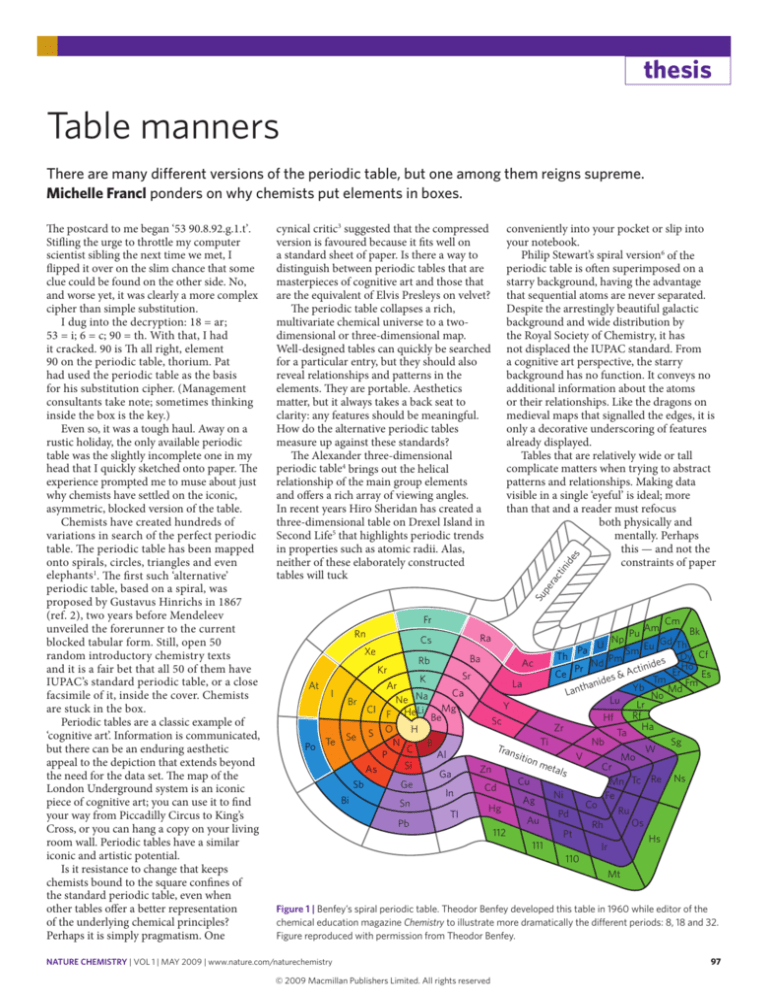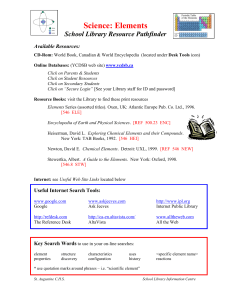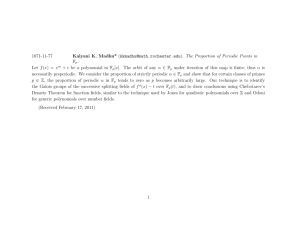
thesis
Table manners
There are many different versions of the periodic table, but one among them reigns supreme.
Michelle Francl ponders on why chemists put elements in boxes.
ra
c
tin
ide
s
conveniently into your pocket or slip into
your notebook.
Philip Stewart’s spiral version6 of the
periodic table is often superimposed on a
starry background, having the advantage
that sequential atoms are never separated.
Despite the arrestingly beautiful galactic
background and wide distribution by
the Royal Society of Chemistry, it has
not displaced the IUPAC standard. From
a cognitive art perspective, the starry
background has no function. It conveys no
additional information about the atoms
or their relationships. Like the dragons on
medieval maps that signalled the edges, it is
only a decorative underscoring of features
already displayed.
Tables that are relatively wide or tall
complicate matters when trying to abstract
patterns and relationships. Making data
visible in a single ‘eyeful’ is ideal; more
than that and a reader must refocus
both physically and
mentally. Perhaps
this — and not the
constraints of paper
pe
cynical critic3 suggested that the compressed
version is favoured because it fits well on
a standard sheet of paper. Is there a way to
distinguish between periodic tables that are
masterpieces of cognitive art and those that
are the equivalent of Elvis Presleys on velvet?
The periodic table collapses a rich,
multivariate chemical universe to a twodimensional or three-dimensional map.
Well-designed tables can quickly be searched
for a particular entry, but they should also
reveal relationships and patterns in the
elements. They are portable. Aesthetics
matter, but it always takes a back seat to
clarity: any features should be meaningful.
How do the alternative periodic tables
measure up against these standards?
The Alexander three-dimensional
periodic table4 brings out the helical
relationship of the main group elements
and offers a rich array of viewing angles.
In recent years Hiro Sheridan has created a
three-dimensional table on Drexel Island in
Second Life5 that highlights periodic trends
in properties such as atomic radii. Alas,
neither of these elaborately constructed
tables will tuck
Su
The postcard to me began ‘53 90.8.92.g.1.t’.
Stifling the urge to throttle my computer
scientist sibling the next time we met, I
flipped it over on the slim chance that some
clue could be found on the other side. No,
and worse yet, it was clearly a more complex
cipher than simple substitution.
I dug into the decryption: 18 = ar;
53 = i; 6 = c; 90 = th. With that, I had
it cracked. 90 is Th all right, element
90 on the periodic table, thorium. Pat
had used the periodic table as the basis
for his substitution cipher. (Management
consultants take note; sometimes thinking
inside the box is the key.)
Even so, it was a tough haul. Away on a
rustic holiday, the only available periodic
table was the slightly incomplete one in my
head that I quickly sketched onto paper. The
experience prompted me to muse about just
why chemists have settled on the iconic,
asymmetric, blocked version of the table.
Chemists have created hundreds of
variations in search of the perfect periodic
table. The periodic table has been mapped
onto spirals, circles, triangles and even
elephants1. The first such ‘alternative’
periodic table, based on a spiral, was
proposed by Gustavus Hinrichs in 1867
(ref. 2), two years before Mendeleev
unveiled the forerunner to the current
blocked tabular form. Still, open 50
random introductory chemistry texts
and it is a fair bet that all 50 of them have
IUPAC’s standard periodic table, or a close
facsimile of it, inside the cover. Chemists
are stuck in the box.
Periodic tables are a classic example of
‘cognitive art’. Information is communicated,
but there can be an enduring aesthetic
appeal to the depiction that extends beyond
the need for the data set. The map of the
London Underground system is an iconic
piece of cognitive art; you can use it to find
your way from Piccadilly Circus to King’s
Cross, or you can hang a copy on your living
room wall. Periodic tables have a similar
iconic and artistic potential.
Is it resistance to change that keeps
chemists bound to the square confines of
the standard periodic table, even when
other tables offer a better representation
of the underlying chemical principles?
Perhaps it is simply pragmatism. One
Fr
Am
Cm
Bk
Eu Gd Th
Sm
Cf
Th
Ba
s Dy
Rb
Nd Pm
Ac
Ho
nide
i
t
Pr
Kr
c
Er
Ce
Es
&A
Sr
K
Tm
des
Fm
La
Ar
At
hani
Yb
t
Md
n
a
L
Ca
I
No
Ne Na
Lu
Br
Lr
Y
Mg
Cl
Li
He
F
Rf
Hf
Be
Sc
Ha
Zr
H
O
Ta
Se S
Sg
Ti
Nb
Te
N
B
Po
Tran
W
C
sitio
Al
P
V
Mo
nm
Si
etal
Cr
Zn
As
s
Ga
Cu
Mn Tc Re Ns
Ge
Sb
Cd
In
Ni
Fe
Bi
Ag
Sn
Co
Hg
Ru
Pd
Tl
Au
Os
Pb
Rh
112
Pt
Hs
111
Ir
110
Mt
Rn
Cs
Ra
Xe
Pa
U
Np
Pu
Figure 1 | Benfey’s spiral periodic table. Theodor Benfey developed this table in 1960 while editor of the
chemical education magazine Chemistry to illustrate more dramatically the different periods: 8, 18 and 32.
Figure reproduced with permission from Theodor Benfey.
NATURE CHEMISTRY | VOL 1 | MAY 2009 | www.nature.com/naturechemistry
© 2009 Macmillan Publishers Limited. All rights reserved
97
thesis
H
He
Li
Be
B
C
N
O
F
Ne
Na
Mg
Al
Si
P
S
Cl
Ar
K
Ca
Sc
Ti
V
Cr
Mn
Fe
Co
Ni
Cu
Zn
Ga
Ge
As
Se
Br
Kr
Rb
Sr
Y
Zr
Nb Mo
Tc
Ru
Rh
Pd
Ag
Cd
In
Sn
Sb
Te
I
Xe
Cs
Ba
Lu
Hf
Ta
W
Re
Os
Ir
Pt
Au
Hg
Tl
Pb
Bi
Po
At
Rn
Fr
Ra
Lr
Rf
Db
Sg
Bh
Hs
Mt
Ds
Rg Uub Uut Uuq Uup Uuh
La
Ce
Pr
Nd Pm Sm
Eu
Gd
Tb
Dy
Ho
Er
Ac
Th
Pa
U
Pu Am Cm
Bk
Cf
Es
Fm Md No
Uus Uuo
Np
Tm
Yb
Figure 2 | Scerri’s periodic table. Eric Scerri proposes a symmetrical version of the periodic table in which
hydrogen is grouped with the halogens, and there are no longer any exceptional periods. Figure adapted
with permission from Eric Scerri.
size — is why extended tables in which
the f-block elements are inserted in their
proper sequence have failed to displace the
compressed versions.
The regularity of grid forms,
particularly square grids, makes them
easier to reproduce from memory — try
reconstructing Benfey’s periodic table
(Fig. 1) or the serpentine presentation of
Gooch and Walker without the original7 in
front of you. You need to know significantly
more about the relationship between
the elements to visualize these tables in
your mind. Jeff Moran’s spiral table8 uses
a hexagonal skeleton to hang the more
complex form on, but still is harder to sketch
than the standard squares.
Font and colour choice seem
inconsequential, but serifed fonts, which
play up the differences between letters, make
a table faster to scan. Bright colours do not
98
always clarify; instead they can confuse
matters by inadvertently drawing your eye
to large blocks of saturated colour. Note how
the actinides, coded lime green on Benfey’s
table, jump out as if they were the most
important elements on the table. (Of course
so do large white spaces; look at the standard
periodic table and note where your eye falls
first — most probably on the white space
above the transition elements!) Good tables
make sparse annotations with thin red lines,
imitating the red lettered instructions or
rubrics in medieval liturgical books.
Scerri has proposed a new variant of the
periodic table (Fig. 2) that, he argues, well
captures the triads of elements9. I would
suggest that as cognitive art Scerri’s version
has potential that the other alternative
periodic tables do not, and so ought to
compete well in chemists’ eyes with the
IUPAC standard. It is compact. There is
less white space to pull the eye away, as
hydrogen and helium move to the first row.
It is symmetrical on a rectangular grid, easy
to hold in the mind. Reactive elements, the
halogens and the chalcogens occupy the
privileged positions on the edges, instead of
the noble gases. It is, I believe, a keeper.
What will the periodic tables of the
future look like? Thin haptic ‘smart sheets’,
perhaps, flat and flexible enough to slip
into pocket or notebook, that switch with
a touch between various tables. Spirals, the
left-hand stack, the extended version and
even rotatable three-dimensional tables
literally at your fingertips.
And the default version on the front
of that high-tech periodic table? I’m
betting it will be a near cousin to Scerri’s
proposed table, in black and white with
red annotations and a serifed font for the
elements — all in all, not so different from
the antique Sargent–Welch wall chart that
hangs over my desk.
❐
Michelle Francl is in the Department of
Chemistry at Bryn Mawr College, Bryn
Mawr, Pennsylvania 19010-2899, USA.
e-mail: mfrancl@brynmawr.edu
References
1. Scerri, E. R. The Periodic Table: Its Story and Its Significance
(Oxford Univ. Press, 2007).
2. Hinrichs, G. D. Programme der Atomechanik, oder die Chemie
eine Mechanik der Panatome (Augustus Hagebock, 1867).
3. Fletcher, G. Murdock’s Lies and the Representation of Information;
available at <http://www.spaceless.com/papers/4.html>.
4. The Alexander Arrangement of the Elements; available at <http://
www.scs-intl.com/alexander.html>.
5. Bradley, J.-C. Useful Chemistry <http://usefulchem.blogspot.
com/2007/10/3d-periodic-table-in-second-life.html>.
6. The Chemical Galaxy — A New Vision of the Periodic Table of the
Elements; available at <http://www.chemicalgalaxy.co.uk/index.
html>.
7. Gooch, F. A. & Walker, C. F. Outline of Inorganic Chemistry, II
(Macmillan, 1905).
8. The periodic table gets a makeover. New York Times (23 October
2006).
9. Scerri, E. R. PhilSci Archive <http://philsci-archive.pitt.edu/
archive/00003095/> (December 2006).
NATURE CHEMISTRY | VOL 1 | MAY 2009 | www.nature.com/naturechemistry
© 2009 Macmillan Publishers Limited. All rights reserved






